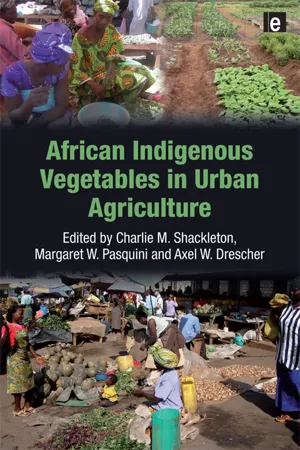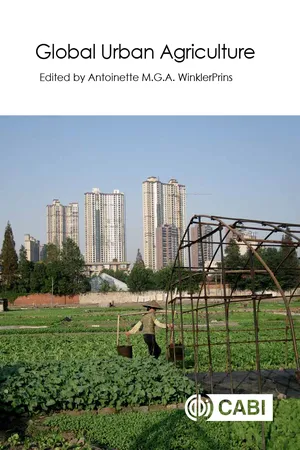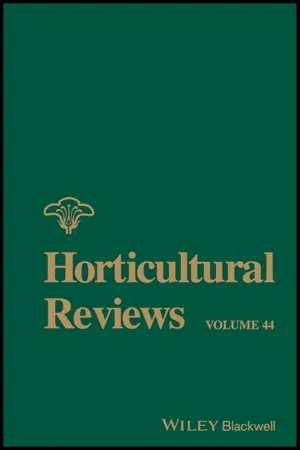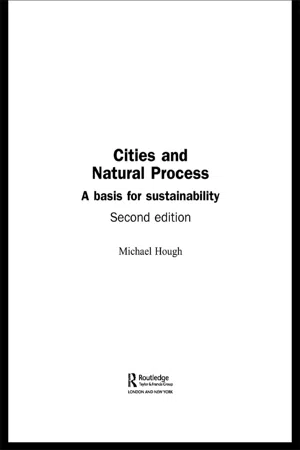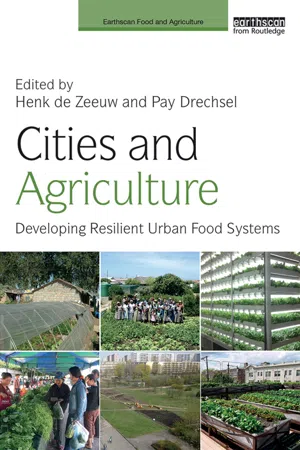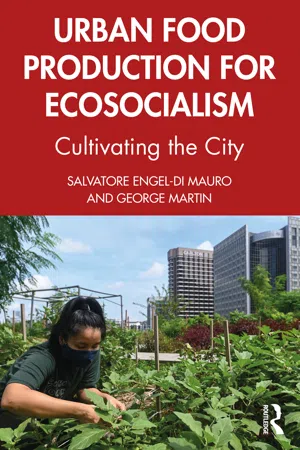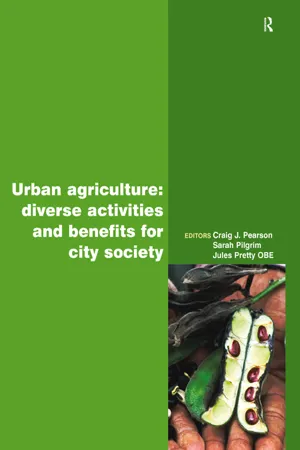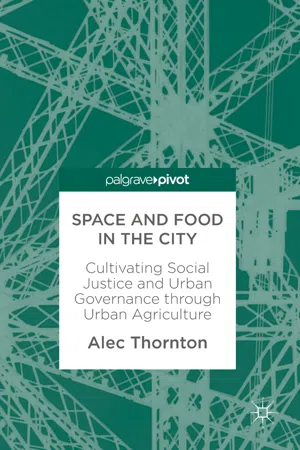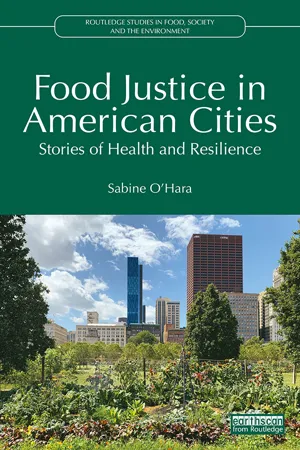Geography
Urban Farming
Urban farming refers to the practice of growing and cultivating food within urban areas, often using innovative techniques such as rooftop gardens, hydroponics, and vertical farming. It aims to increase access to fresh produce, promote sustainability, and reduce the environmental impact of food production and transportation in cities. Urban farming also contributes to community engagement and education about food systems.
Written by Perlego with AI-assistance
Related key terms
Related key terms
1 of 4
Related key terms
1 of 3
11 Key excerpts on "Urban Farming"
- Charlie M. Shackleton, Margaret W. Pasquini, Axel W. Drescher(Authors)
- 2009(Publication Date)
- Routledge(Publisher)
Chapter 3 includes an overview of important indigenous vegetables and their production in Africa. An overview of important urban crops can be found in Tixier and de Bon (2006). In the following sections, specific crops will be mentioned in connection with the cited literature.Location, tenure and farming practices
Urban Farming exhibits a wide variety of cropping practices, ranging from what can be considered conventional horticultural production, in some cases even in greenhouses, to ingenious space and resource-conserving structures, such as the compost mound. As space is the main limitation in several Urban Farming systems, it is not surprising that many characteristic urban production systems seek to optimize production per unit area, usually by developing vertical structures for plant production (see Plates 2.1 and 2.2 ).Urban Farming takes place on most land types in cities. The following subsections distinguish between the different types of land used for farming, as this also has an impact upon the nature of the cropping system (Brock and Foeken, 2006).Private garden farming
Private garden farming is found in all cities throughout the world. It is the most obvious and most widespread form of Urban Farming. Even when there is no access to a garden, farming may still be practised on rooftops, balconies or on walls. The private garden has a number of distinguishing features. First, there is no transport time to the site, making management convenient, and allowing for collection of minute quantities of harvest (Cockram and Feldman, 1996). Second, the crop is well protected and the risk of theft or vandalism is minimized. Land tenure is usually secure, allowing for longer-term investments of time and space in, for example, fruit trees. Water availability is usually better than for gardens away from the house, although irrigation with domestic water may not be feasible or desirable from a wider perspective. Finally, the farmer has a high level of control over inputs to the system. In most cases, production will also be quite limited due to the constraints in size. Although private gardening occurs in most communities, it is likely to be of lesser importance for the most destitute and resource-poor citizens as they have less access to own land than middle- and higher-income households. Similarly, larger households are often more active in Urban Farming than small due to better access to land and more available hands (Atukunda and Maxwell, 1996; Gumbo and Ndiripo, 1996; Mboganie-Mwangi and Foeken, 1996).- eBook - ePub
- Antoinette WinklerPrins, Antoinette WinklerPrins(Authors)
- 2017(Publication Date)
- CAB International(Publisher)
urban agriculture is the production, processing and marketing of food and related products in urban and peri-urban areas, usually through intensive cultivation and for consumption in the same urban or peri-urban area. The existing literature covers a wide range of practice that some call ‘gardening’ and some call ‘agriculture’. Gardening usually connotes leisure, aesthetics and recreation, small scale, and in some parts of the world is women’s domain. In contrast, farming typically connotes production for subsistence or commercial purposes. It refers to a livelihood, a way of life, and is usually practised on a relatively larger scale than gardening. In many parts of the world, farming is associated with men and is considered a male domain. The reality is that, in practice, much of what we have traditionally talked about in UA is gardening, but it has taken on elements of farming and there is semantic fluidity between the two. Neither term is entirely satisfactory for encompassing what actually occurs, and therefore I suggest that instead of using the terms ‘gardening’ and/or ‘farming’ that we refer to this suite of activities as ‘urban cultivation’ and refer to the people who practise it as ‘urban cultivators’. This is difficult to do given the deep embeddedness of the term ‘urban agriculture’, which is why in this volume there will be a mix.Urban cultivation encompasses plants being grown for some utility, but also includes activities that involve animals. This may range from home gardeners keeping or enabling bee foraging in their yards through the planting of appropriate flowers to the keeping (legally or not) of chickens or other fowl, to the maintenance of cows (usually for milk) or even horses and other animals. Although more common in the GS, the keeping of poultry as part of the home-garden system is gaining traction in many cities in the GN as the health benefits of free-range and locally produced eggs and meat have become clear. Activists in cities large and small in the GN are working on the legal issues of keeping poultry, while those in the GS work to keep such activities from becoming illegal. - eBook - ePub
- Jules Janick, Jules Janick(Authors)
- 2016(Publication Date)
- Wiley-Blackwell(Publisher)
Quantifying the direct value of these ancillary economic benefits only captures part of their potential to impact a place. In addition to converting vacant land, some new housing developments are also fostering urban farm sites as desirable neighborhood focal points. These neighborhoods with a farm at the center generated the term “agrihoods” (Murphy 2014; Gittelsohn 2015). Yes, farming, for some, is the new golf. The struggle to make an urban farm profitable contrasts the desire for communities to benefit from it, and there is not always a willingness or means for the market to pay for the true value of urban agriculture. Thus, urban agriculture has a clear place in a sustainable economy providing benefits to communities. It is not clear, however, that the current economy can sustain urban agriculture if these benefits go unappreciated.Urban agriculture has clear potential to spur the development of local economies in developing countries, providing both increased food security and significant job opportunities (Agbonlahor et al. 2007). Huge greenhouse operations have sprung up in parts of East Africa in the last few decades, particularly in the Kenyan Highlands near Nairobi. Their impact is somewhat contentious because these operations almost exclusively target export markets, mostly for flowers, and they withdraw large volumes of groundwater and other resources with potentially disastrous long-term consequences (Harper et al. 2011), but they do provide large numbers of jobs (Dolan and Sutherland 2002), even though they do little to increase local food supplies to local communities that spend most of their income on food (Mougeot 2005). Support for urban agriculture projects that explicitly target low-income and malnourished local populations are needed.Along with urban farms and other near-city small farms come a range of associated businesses. Local foods spur the development of food hubs, farmers' markets, local food delivery services, and the supply of urban food pantries, each of which serves to increase the supply of local foods, the provision of jobs and increases urban food security. - eBook - ePub
- Michael Hough(Author)
- 2004(Publication Date)
- Routledge(Publisher)
5City farming
Introduction
In the twenty-first century the food we eat, where it is grown and produced, is a commentary on the conflicts that exist between urban and rural values and social perceptions towards the land. To most urban people, the countryside is a recreational resource – a place of escape from the city. The food that appears in the supermarket has little direct connection with the actual process of growing food and how it gets to the table. It is instead dependent on worldwide marketing and distribution networks operating on fossil fuels and based on international trade agreements, but there are signs that patterns of consumption and environmental priorities are shifting. One of the indicators of change may be found in the pursuit of a more healthy diet. This is reflected in the growth of health food stores, farmers’ markets, organic food growing and allotment gardening, suggesting there are signs of a return to home-grown versus ‘factory-made’ food. In this chapter we explore how the links between people, food growing, ‘waste’ and city space can be creatively re-established as a central aspect of environmental and social values, and how the fundamental links between food and sustainability can, and must, reshape our thinking about cities.Agriculture: process and practice
Productivity
Agricultural systems are human-made communities of plants and animals interacting with soils and climate. Unlike self-perpetuating natural systems, they are inherently unstable. Cultivation, harvesting and the biological simplicity of a few species inhibit the recycling of nutrients and make them susceptible to attack from pests. The degree to which agricultural systems can be stabilized depends on factors such as soil fertility, the extent to which animal nutrients are recycled and the diversity of plant and animal species under cultivation. Traditional mixed farming practice, while varying widely in the type of cultivation and rapidly becoming extinct in most industrialized nations, has maintained a certain degree of ecological balance. The enclosed field systems of European agriculture relied on nutrient input from farm animals, crop rotation and variety and the natural communities of hedges and woodlands to offset nutrient loss due to the harvest and the depredations of pests. Energy inputs to the system before the age of fossil fuels were limited to horses and men to pull the ploughs, sow the seed and thresh the grain. Fossil fuels provided the fundamental breakthrough. The rubber-tyred tractor replaced human and animal labour. Chemical fertilizers and pest control agents replaced earlier and necessary biological methods of maintaining stability. Fossil fuels enabled agriculture to increase its efficiency, size and productivity, while decreasing its labour inputs. - eBook - ePub
Cities and Agriculture
Developing Resilient Urban Food Systems
- Henk de Zeeuw, Pay Drechsel, Henk de Zeeuw, Pay Drechsel(Authors)
- 2015(Publication Date)
- Routledge(Publisher)
The rural–urban relationship in the future is likely to be seen as a continuum, rather than as a relationship between discreet entities. Equally, future farming practices will most likely happen on a spectrum, combining social and economic benefits and utilizing a range of technological approaches.Regardless of the type and location of farming, it is evident that appropriate tenure agreements for farmers will be critical for long-term success, especially when involving livelihoods. Where food security is not a major driver, specific ways of adding value to intra- and peri-urban enterprises are required, especially where land is scarce and expensive.Urban policy is being developed by some cities to support and remove barriers to the implementation of intra- and peri-urban agriculture. But the speed at which intra-urban projects are being established, for example in Europe and North America, or peri-urban agriculture is being lost, for example due to urban expansion in Africa, is outstripping the speed at which supportive policy is being developed. Successful pathways to policy need to be found urgently. If this shift is to be consolidated, then the next step is to collect and disseminate metrics to encourage its further integration into intra- and peri-urban design.Summing up: During the last decade a lot has happened enabling and supporting the integration of urban agriculture into cities in the Global South and North, but a conceptual shift is still required, if agriculture is to become and remain valued as an essential element of urban infrastructure.References
Allen, A.; Apsan Frediani, A.; Wood-Hill, M. 2014. Land and planning for urban agriculture in Accra: Sustained urban agriculture or sustainable urbanization? In: Irrigated urban vegetable production in Ghana. Characteristics, benefits and risk mitigation. (Eds.) Drechsel, P.; Keraita, B. Colombo: International Water Management Institute (IWMI), 2nd edition, pp. 161–179.American Forests. 2000. CITYgreen software. Available from: www.americanforests.org/garden/treescities_sprawl/citygreen/index.html .APA (American Planning Association). 2007. Policy guide on community and regional food planning. Washington, DC: American Planning Association (APA). Available from: www.planning.org/policy/guides/adopted/food.htm - I.R. Bowler(Author)
- 2014(Publication Date)
- Routledge(Publisher)
10Farming at the urban fringe
Christopher BryantIn this final chapter attention is turned to one particular context for farming, namely those urban fringe zones that surround large urban concentrations (also called metropolitan regions). The aim is to bring together a number of themes that have been introduced in earlier chapters, and to discuss the ways in which they interact in one farming context. Urban fringe areas have been chosen because processes of urbanization are increasingly dominant in developed countries, while the effects of urbanization are most clearly demonstrated at the urban fringe. Even so, we can anticipate the influence of urbanization continuing to extend further from our metropolitan areas with the passage of time.Urbanization, associated with the process of economic development, has been one of the most general trends in society in the last half-century. It influences many facets of modern life and is accompanied by changes that have had far-reaching effects upon agriculture and the agricultural production system, including its support services and industries. This simple stimulus- response interpretation, of course, should not be taken as acceptance of the view that agricultural change is only reactive in relation to changes in the broader socio-economic system. Certain types of agricultural change originate from within the agricultural sector. For example, the development of novel types of farm enterprises can create markets and are not always a reaction to them- for instance, the development of kiwi fruit production in New Zealand in the 1960s and 1970s - and the development of new technologies of production. Furthermore, in some respects agricultural activity may influence certain aspects of the urbanization process; for example, particular farm production systems associated with individual types of landholding structure (intensive market gardening) may influence the form and spatial structure of the urban development process. Consequently, we must recognize that there is a two-way interaction between agriculture and the non-farm sectors of the socio-economic system.- eBook - ePub
Urban Food Production for Ecosocialism
Cultivating the City
- Salvatore Engel-Di Mauro, George Martin(Authors)
- 2021(Publication Date)
- Routledge(Publisher)
If urban produce is grown and consumed by disadvantaged groups benefits may be more significant. One study shows that it can make a substantial contribution to the tables of low-income immigrants from agricultural backgrounds (Mares and Pena 2010). Also, the CDC (2010) in the US inventoried examples of community gardens’ efforts that make substantial inputs to improving the diets of low-income persons with high rates of obesity and diabetes and with limited sources of fresh produce. However, these are special cases, in which volunteer and experienced gardeners had convenient access to free plots of arable land, not a common situation for low-income residents of cities in the global North. There are several socioeconomic factors that constrain urban food production, including a lack of skilled gardening labour and operational capital. For example, a case study of food-growing sites in Houston revealed that their major challenge—by a large margin—was finding committed and craft-knowledgeable volunteers for the substantial physical labour required to grow food (Broadstone and Brannstrom 2017). Additionally, securing money for gardening tools and supplies was a challenge for the 31 sites; nearly half relied heavily on financial support from charitable and non-profit organisations.The fundamental limitation to urban cultivation’s production potential remains a material one—the scarcity of arable land. Field production is simply beyond the land capacities even of enormous urban agglomerations, including those in the global South, where peri-Urban Farming is being overwhelmed by urban expansion. In the face of the optimistic scaling scenarios rooted in localism, an optimisation modelling of the production of temperate and tropical cereals, and tropical roots and pulses, demonstrated that only 11–28 per cent of them could be grown within a 100 km radius of urban centres (Kinnunen et al. 2020). Cities, by virtue of the reality of being cities, cannot grow what has become the basic food of humanity—cereal grains, the stuff of the traditional “staff of life.” Cereals supply over half the dietary energy of humanity (FAO 2010), and large rural fields are the venues for their efficient and sustainable production. For example, research indicates that peak efficiency in growing is achieved with production units of 160 to 325 ha for soybean and 325 to 490 ha for maize (Duffy 2009). Such large-scale production efficiencies are critical to providing for food output, which is greatly hampered by the expansion of meat-based diets and biofuel production, and newly exposed to the extreme negative impacts of global warming (IPCC 2014; USDA 2013). - eBook - ePub
Urban Agriculture
Diverse Activities and Benefits for City Society
- Craig Pearson(Author)
- 2011(Publication Date)
- Routledge(Publisher)
et al., 2008). We contend that human-scale municipal-focused agriculture should form the basis of a bio-regional agri-food system as a necessary precondition for creating local and regional food security (supply) and food sovereignty (control). This perspective raises several key research questions for us, relating to how food systems should be configured to contribute to more sustainable, liveable urban centres, while enhancing the agri-food sector:• How might urban and peri-urban agriculture be tied directly into the ecological and social function and economic vitality of our cities? • How can human-scale agri-food production realize sustainability objectives while contributing to lessening the urban ecological footprint? • How can human-scale, urban-linked agri-food systems contribute to the social fabric of our cities providing opportunity for productive, healthy human engagement and enterprise?We explore these questions through a combination of a recent case study and field-based research which is being conducted with private sector, municipal government and community-based partners, in a geographic arena that is struggling to contend with significant growth management challenges.Metro Vancouver and the Agricultural Land ReserveIn 2009 a white paper entitled Agriculture on the Edge (Condon and Mullinix, 2009) was written by two seasoned academics and introduced at a summit of invited regional leaders representing various sectors and interests by a former premier of the Province of British Columbia. The objective of the paper and summit was to stimulate discussion around the inherent tensions that currently exist between rapid urbanization and the encroachment onto land zoned for agriculture in the Metro Vancouver region, and to call attention to the urgent need to abate urban encroachment on agricultural lands by promoting viable agriculture as an integral element of urbanization.The authors examined the dynamic interplay of competing forces (urban growth vs. preservation of farmland) ‘at the edge’ and proffered ideas that were intended to stimulate discussion on potential formulations of land-use plans and public policies that would encourage and enhance agriculture while simultaneously accommodating the anticipated doubling of the region’s population over the next 20–30 years (Baxter, 1998). Their concept paper included a provocative suggestion that a 500m zone of land at the interface of the urban and agricultural lands could be considered for an innovative approach to creating enhanced agriculture. The proposal was to capture the ‘value lift’ on a 200m corridor of the land after it had been rezoned to allow urban development, and use the monies derived from this ‘lift’ to stimulate and finance enhanced agriculture through a form of ‘community trust farming’. - eBook - ePub
Youth Urban Worlds
Aesthetic Political Action in Montreal
- Julie-Anne Boudreau, Joelle Rondeau(Authors)
- 2021(Publication Date)
- Wiley(Publisher)
It was pouring rain on that workshop day, and the temperature was ideal for transplanting the perennial plants and fruit trees that Ben had brought, partly from his own nursery production and partly from a nursery located on the Montreal Island. As the apprentices rubbed the roots of plants and fruit trees, shook up soil agglutinations, and dipped the matter into a bucket of water inoculated with mycelium and other fungi in order to kickstart a symbiotic communication network between the roots and the microorganisms living underground, they learned the principles of ‘food forest’ design and cultivation. Among other plants and tools, they teamed up with black and purple raspberries, grape vines, trellises, pear trees, pink champagne currents, alfalfa, oat, clover, and lupens, all of which they planted densely together in order to harness their synergistic potentials. On a flat area of grass lawn laid out in the iconic American campus style, a multispecies edible collective was arranged. By design, the metabolic actions of nitrogen‐fixing plants (alfalfa, clover) benefit other species, while the long tap root of other plants (lupen among them) transports heavier minerals up into soil layers closer to the roots of fruit trees. Over time, the shade of the trees’ canopies will offer cool microclimates to the plants below, while the trees themselves will provide natural habitats for birds and offer students and neighbours a little something tasty to eat, free of charge. Does urbanity affect the ways in which youth think about agriculture and grow food today? In this ethnography, we enter the urban political world of beginning and aspiring urban farmers.Vegetable garden beds covered with mesh, located in front of a medicinal garden plot and some fruit trees (top right) planted on the day of a food forest design workshop. Behind the garden is a residential street, while City Farm School’s market stand is located in the building on the far left.FIGURE 4.1Source: photo by Joëlle Rondeau, July 2014.The Market‐Gardener Apprenticeship Program involves an eight‐month apprenticeship at the City Farm School, taking place over a whole growing season, from seedling production at the Concordia Greenhouse in March to the closing of production plots and markets at Loyola campus in October. It is not part of the university’s curriculum. In fact, City Farm School was constituted as a nonprofit organization two years after its founding in 2011, in order that it could continue operating on institutional lands while offering experience‐based education in urban agriculture and selling crops at farmers’ markets. The training programme was ‘designed to create urban farmers who are interested in taking their veggies to market, while also working collectively to design and manage a typical scale community garden plot’ (City Farm School 2014b ). To this day, it is unique in the Province of Quebec and in Montreal in providing hands‐on training, guest lectures, and teach‐ins on small‐scale organic food production and distribution, as well as food sovereignty and food politics.The programme, however, shares similarities with Urban Farming training programmes that have emerged in North American postindustrial cities in response to growing social and professional demands for farming and horticultural training in urban environments, including Detroit’s DTown Farm, Milwaukee’s Growing Power, Chicago’s City Farm, and Boston’s Food Project. These emergent urban agriculture education infrastructure systems and knowledge networks are gaining increasing attention in popular and academic literature (Bryant 2012 ; Ewert 2012 ; Hanson and Marty 2012 ). Developed over recent years by actors outside of the formal institutional agriculture education infrastructure (e.g. community organizations, social enterprises, student collectives), they provide training on modes of food production and distribution specifically adapted to urban environments. Their production sites differ from conventional farms in that they are often interstitial, small‐scale, and networked (Bryant 2012 ; Hanson and Marty 2012 - eBook - ePub
Space and Food in the City
Cultivating Social Justice and Urban Governance through Urban Agriculture
- Alec Thornton(Author)
- 2018(Publication Date)
- Palgrave Pivot(Publisher)
It is in this context that local networks of small-scale inner-urban and larger scale peri-urban food production (or UA), in green zones and rooftops, in suburbs and in smaller towns, must be recognised as contributing to the food needs of its urban populations. In parts of Europe and North America, for example, these networks exist and are expanding under community supported agriculture and other AFN (Goodman et al. 2011). Such methods are proving to be viable alternatives to mainstream monoculture crop production (see IAASTD 2009), with permaculture methods used in urban areas where space to grow food is limited, particularly in the inner-city regions, and often requiring more intensive production. Discussed in a later section, city managers are reviewing bylaws and ordinances in an effort to zone for various form of UA. However, this is proving more effective in cities in the global North, less so in the South. Among the important changes to city ordinances has been commercial zoning for UA, thus allowing for the production and marketing of urban produce and foodstuffs sourced from backyards, community and market gardens and urban farms. The following section will explore the impact of local level institutions, or grassroots groups, as drivers of social movements in claiming their ‘rights to the city’ for local or urban food production. Social Movements and the Production of Food Space Urban spaces are becoming increasingly commodified and, in response, communities are claiming their ‘rights to the city’. A ‘right to the city’ is essentially a collective response by urban communities to ‘take back’ neoliberal dominated urban space for social use (Lefebvre 1991). For David Harvey (2008 : 23), rights to the city is also the “freedom to make and remake our cities and ourselves [and is] one of the most precious yet most neglected of our human rights” - eBook - ePub
Food Justice in American Cities
Stories of Health and Resilience
- Sabine O'Hara(Author)
- 2023(Publication Date)
- Routledge(Publisher)
This type of urban business cluster will undoubtedly require training and technical support, as well as financial assistance. However, it will likely repay this investment many times over through its social, environmental, and economic contributions to the local community. This brings us to restorative urban agriculture (O'Hara and Stuiver, 2022). Based on the concept of sustaining production (O'Hara, 1997 ; 2016), this adds several critical dimensions to local and sustainable urban agriculture. In addition to the familiar notion of production efficiency, restorative urban agriculture focuses on sink capacities: that is, an ecosystem’s ability to absorb, process, and ameliorate harmful substances. It thus addresses one of the chief failings of conventional agriculture, which for too long has acted as if it operates independently of the social and environmental systems that provide its resources and receive its emissions and waste by-products. For example, producing vegetables requires labor, water, fertilizer, and soil minerals or nutrient-rich water. As Chapter 1 pointed out, most of the focus in agriculture has been on producing ever-higher crop yields with the same or fewer inputs, and especially with less labor. Agriculture has been wildly successful in this respect, freeing up workers and enabling them to enter other economic sectors. Over the past 50 years, a secondary focus has been on reducing both nutrient run-off from fertilizers and pesticide residues on food plants. Yet, only recently has attention started to shift from increasing efficiency and reducing emissions to the contributions that agriculture could make to improving ecosystems and the services they provide (O'Hara and Stuiver, 2022). For example, soil can sequester carbon and reduce carbon-dioxide emissions; increasing soils’ capacity to absorb water can mitigate flooding; and maintaining biodiverse ecosystems can provide habitats for the pollinators that make crop production possible
Index pages curate the most relevant extracts from our library of academic textbooks. They’ve been created using an in-house natural language model (NLM), each adding context and meaning to key research topics.
Explore more topic indexes
Explore more topic indexes
1 of 6
Explore more topic indexes
1 of 4
